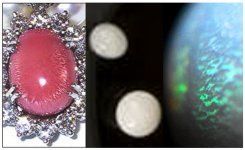Dr. Tom actually said a laser was not used, but never posted a full picture of the subject pearl for perspective despite repeated requests. And we continue to wait for Effisk?We continue to be teased!
But I can't get Dr. Tom's image out of my mind, with its seemingly holographic floating surface?the closest thing to the classicist's description of 'orient' I've seen anywhere?said phenomenon reputedly impossible to photograph, also dependent upon diffraction caused by the unique properties of aragonite platelets and platelet suture patterns of nacreous round pearls.

